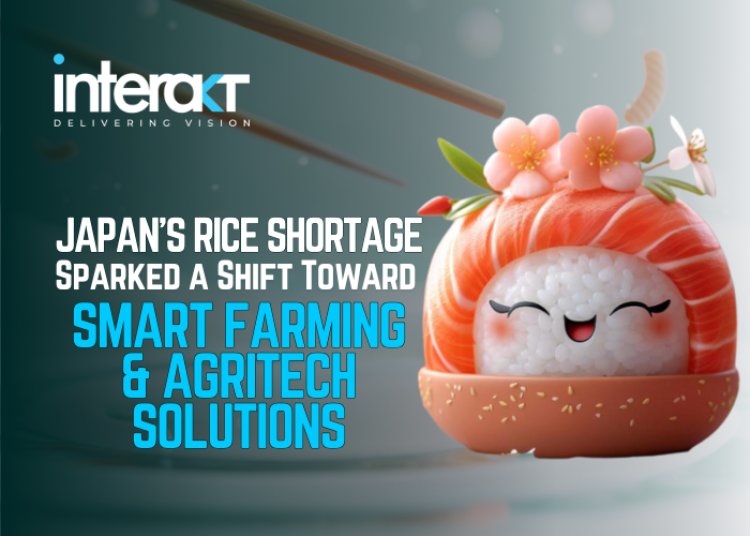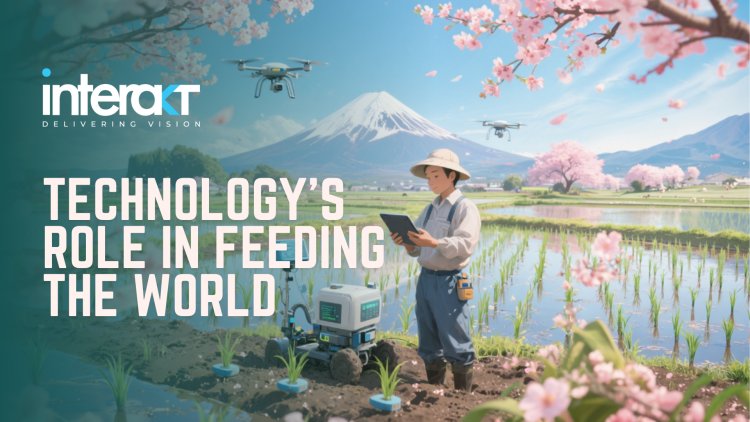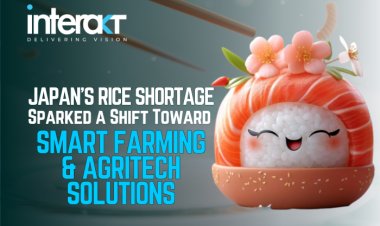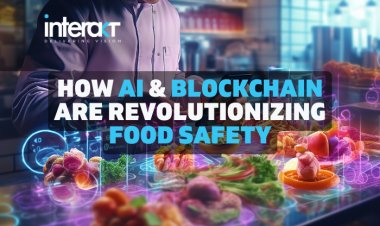How Japan’s Rice Shortage Sparked a Shift Toward Smart Farming and AgriTech Solutions
Japan’s rice crisis exposed global vulnerabilities in food systems. Explore how AgriTech, smart farming, and AI are driving agriculture’s digital future.

Key Highlights
- Japan’s rice crisis triggered a national emergency, with 70% price spikes and first-time imports from South Korea, exposing systemic agricultural vulnerabilities.
- government-imposed rice production limits, paired with climate volatility and an aging farmer population, created a perfect storm of supply shortages.
- including autonomous tractors, AI-powered crop forecasting, solar IoT sensors, and GNSS-based field tracking.
- Blockchain and Web3 initiatives in Japan (like the Kokudaka Project) are driving traceability, transparency, and digital farmer–consumer connections.
- CRISPR-edited, heat-tolerant rice and rice engineered to produce milk protein are redefining crop functionality.
- Countries like India, Brazil, and the UAE are scaling AgriTech at pace, digitizing millions of farmers, launching vertical farms, and optimizing vast acreage through AI and robotics.
- AgriTech is no longer experimental—it’s essential. The global market is projected to grow from $60.5B in 2025 to $137.8B by 2034, with precision farming, automation, and biotech at the forefront.
- This crisis shows that the next agricultural revolution won’t be powered by pesticides, but by algorithms, satellites, and sustainability-driven systems
In an era of climate disruption, population growth, and shifting trade dynamics, agriculture is no longer just about soil and seeds; it’s about satellites, sensors, AI, and sustainable systems.
Nowhere is this shift more urgent than in Japan—a nation known for precision and tradition—where a national rice supply crisis is exposing the vulnerabilities of outdated agricultural systems. But what began as a domestic disruption has quickly become a case study for the world.
As we face the daunting task of feeding a global population of 9.7 billion by 2050, Japan's crisis offers a clear message: technology isn’t just a tool, it’s the path forward.
Case Study: Japan Rice Crisis: A Wake-Up Call for Global Agriculture
What’s Behind the Crisis?
For decades, Japan paid farmers to reduce rice production to avoid oversupply. Now, with inflation, labor shortages, and erratic climate patterns disrupting yields, the government has reversed course, urging farmers to grow more rice for the first time in decades.
Key factors driving the crisis:
- Price Spike: heatwave and low-quality harvest triggered a national stock drop (~1.53 M t), leading to prices nearly doubling (from ~¥2,000 to ¥5,000/5 kg) and rationing in supermarkets. Retail rice prices are up ~70% YoY due to reduced planting and poor harvests.Source: AP News
- Aging Farmers:: With an average farmer age of ~67 and only 700,000 small farms left (down from 4.7 M in 1970), there are neither enough hands nor young farmers to scale production.Source: EconLife
- Climate Volatility: Shifting weather patterns have shortened growing seasons and introduced unpredictable floods and droughts. Frequent heatwaves have degraded rice quality—only ~60% meets premium grade vs. ~75% previously—impacting consumer acceptance and price stability Source: Japan Today
- Geopolitics & import dynamics: Trade pressure (e.g., from the U.S.), rising tourism, and dietary shifts led to increased rice imports—from the U.S., Taiwan, Thailand, and Vietnam—complicating domestic production policies reuters.com.
- Import Dependency: Japan began importing rice from South Korea for the first time in over 25 years. Rising global demand and geopolitical pressure complicated policy-making.
Source: Reuters
Japan’s situation highlights the fragility of agricultural supply chains—even in high-tech economies—and the urgency for integrated, digital, and climate-resilient solutions.
Technology’s Role in Feeding the World: AgriTech as the Global Response
AgriTech is no longer about innovation; it’s about adaptation and survival. Technologies like IoT, AI, robotics, and blockchain are already being used around the world to improve yield, reduce waste, and respond to labor shortages.
Here’s how:
1. Autonomous Robotics & GPS-Guided Machinery
Japan’s rice fields are being managed by Agri Robo machines—autonomous tractors and planters that can operate with minimal human intervention. Manufacturers like Kubota and Yanmar are deploying autonomous tractors capable of planting, weeding, and harvesting with minimal human input. In Fukuoka, a 60-hectare farm is maintained by just three people using such systems.
Globally:
- The use of autonomous drones and tractors is projected to grow at a CAGR of 13.5% through 2030.
- India and Brazil are investing in satellite-guided sowing and harvesting systems to scale up production without increasing headcount.
2. AI-Powered Crop Forecasting & Disease Detection
Satellite and drone imagery combined with AI now enable real-time yield estimation and disease detection, empowering early intervention and precise field management
Meanwhile:
- Kenya uses AI models to predict maize disease outbreaks weeks in advance.
- In the U.S., AI imaging systems detect plant stress with 90%+ accuracy, saving crops before visible symptoms appear.
3. IoT & Precision Farming: Real-Time Control at the Root
IoT sensors in rice paddies help monitor water levels, temperature, and soil nutrients—automatically adjusting irrigation and fertilization. One prototype used solar-powered sensors to regulate paddy irrigation, reducing labor and water consumption. This kind of precision agriculture is helping countries like Japan reduce waste and optimize yield in shrinking arable land.
- The Netherlands, a leader in greenhouse IoT systems, produces 5x more vegetables per square meter than the global average.
- Israel’s drip irrigation systems save over 70% of water compared to traditional flooding techniques—critical for rice-producing countries facing droughts.
Low-Cost IoT + GNSS to Track Field Operations
A Japanese pilot retrofitted tractors with LTE, GNSS, and BLE beacons to auto-record 1,600+ field activities—cutting data errors and improving management insights

4. Blockchain Traceability and Web3 Integration
Japan’s “Kokudaka” project uses blockchain and Web3-based systems to connect rice producers with consumers, providing digital proof of origin, sustainability credentials, and fair trade practices.
A Web3 pilot in Fukushima supports aging farmers, boosting local economies via verified product storytelling.
Globally:
- Thailand is testing blockchain to validate jasmine rice authenticity.
- Walmart uses a blockchain-based food traceability system in the U.S. to reduce food fraud and improve supply chain transparency.
5. Biotech & Future Farming: The Rise of Molecular Crops
Japanese startup Kinish is developing rice plants that produce casein—a protein found in milk—by editing plant genetics. This could revolutionize both the dairy and farming industries by turning rice into a biomanufacturing platform.
Elsewhere:
- In the Philippines, Golden Rice (biofortified with Vitamin A) is being deployed to combat malnutrition.
- CRISPR gene-editing is being used in China and Brazil to make rice more drought-tolerant and pest-resistant.
6. Climate-Resilient Breeding
Trials of heat-resistant rice such as “emihokoro” in Saitama show promise: its resilience is critical as yields are projected to fall by ~20% by 2100 if heat tolerance isn’t improved reuters.com.
Global Trends: Technology Transforming Agriculture Worldwide
Emerging Technologies: The Future of Agriculture
Digital Twins: Virtual Farming Revolution
Digital Twin (DT) technology has emerged as a transformative tool in various sectors, like agriculture, due to its potential to improve productivity, sustainability, and decision-making processes.
Key Applications:
- A virtual replica of the crop, including key agronomic development aspects such as irrigation, optimal fertilization strategies, and pest management, can support decision-making and a step change in farm management
- Risk Reduction: Identify and address potential issues before they escalate. Resource Optimization: Minimize waste and maximize efficiency
CRISPR and Gene Editing: Precision at the Molecular Level
The Global Agricultural Biotechnology Market, valued at USD 60.5 billion in 2025, is set to reach USD 137.8 billion by 2034, growing at a 9.6% CAGR.
Revolutionary Applications:
- Researchers can use CRISPR tools to create more nutritious plant varieties. For example, they can make some plants produce more vitamins, like so-called "golden bananas" that have a richer color due to their increased beta carotene
- Gonzalez et al. reported a successful application of CRISPR for reducing enzymatic browning in potato tubers by targeting the polyphenol oxidase (PPO) 2 gene (StPPO2). Disrupting this gene led to a 73% reduction in enzymatic browning
- Gene drives engineered through CRISPR technology can spread heat tolerance traits rapidly through plant populations, potentially transforming the resilience of an entire crop in a few generations
AI and Machine Lerning Integration
AI-powered bioinformatics tools will enhance the precision of crop improvement programs, reducing breeding cycles and accelerating genetic advancements.
Japan's rice crisis will be remembered not as a disaster, but as the catalyst that accelerated a global agricultural transformation. What began as empty supermarket shelves in Tokyo has evolved into a worldwide revolution reshaping how humanity feeds itself—from the rice paddies of Niigata to the vertical farms of Dubai, from the vast soybean fields of Brazil to the smallholder plots of Nigeria.
The next agricultural revolution won’t be driven by plows or pesticides—it will be powered by algorithms, satellites, sensors, and code. And the decisions we make today, about how we grow, manage, and secure our food systems, will define whether the world is truly food-secure tomorrow.
Japan’s rice crisis is not just a regional disruption. It’s a mirror reflecting the urgent need for technology-driven agriculture that's intelligent, adaptive, and resilient. What once seemed like distant innovation is now a necessity.
As this global transformation unfolds, one truth is clear:
Innovation knows no borders, and necessity remains its most powerful catalyst.
At Interakt Techsol, we envision agriculture not just evolving, but transforming into a data-driven, tech-empowered ecosystem that feeds both people and progress. From the fields of Niigata to the farms of Nairobi, it’s time to rethink farming for a digital, sustainable future.
The soil is ready. The code is written. Now we grow.












